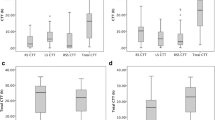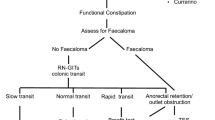Abstract
Background
Rapid proximal colonic transit with anorectal holdup is a subtype of chronic constipation linked to food intolerance. We aimed to determine the effectiveness of dietary exclusion as a treatment for constipated children with rapid-transit constipation by scintigraphy.
Methods
Questionnaires on diet and symptoms were mailed out to 125 children with chronic constipation and rapid proximal colonic transit on nuclear transit study at our institute between 1998 and 2014 years. Patients were given instructions and encouraged to undertake a six-food elimination diet targeting common protein allergens (dairy, wheat, soy, eggs, nuts, seafood). Answers were completed by circling an option or on visual analogue scale. Results were evaluated statistically using GraphPad Prism 6 by a Wilcoxon matched-pairs rank test. P < 0.05 was considered significant.
Results
We received 44/125 responses, 26 patients [mean age 11 years (5–21)] had attempted elimination diet and 18 had not. Dairy and wheat were the most common foods eliminated and symptomatic improvement was greater for patients who had completely eliminated foods. Constipation, abdominal pain and pain on defecation were reduced (p < 0.01). Laxative usage decreased, although this was not statistically significant. Families encountered problems with dietary exclusion, particularly expense. Assistance from a dietician or nutritionist was sought by >50 % of families.
Conclusion
Dietary exclusion is a promising strategy to treat constipation in children with rapid proximal colonic transit. However, it was hard for many families, demonstrating the need for identifying the cause more specifically and a better set of instructions for the family and/or dietitian to follow.



Similar content being viewed by others
References
Hyams J et al (2002) Functional gastrointestinal disorders: working Group Report of the First World Congress of Pediatric Gastroenterology, Hepatology, and Nutrition. J Pediatr Gastroenterol Nutr 35(Suppl 2):S110–S117
Nunez RM, Fabbro MA (2013) Contipation in children: diagnosis and treatment. In: Fabbro MA (ed) Public Health in the 21st Century. Nova Science Publishers, New York
Sutcliffe JR, King S, Hutson JM, Cook DJ, Southwell BR (2009) Gastrointestinal transit in children with chronic idiopathic constipation. Pediatr Surg Int 25(6):465–472
Wheatley JM et al (1999) Slow-transit constipation in childhood. J Pediatr Surg 34(5):829–832. (discussion 832–3)
Shin YM et al (2002) Signs and symptoms of slow-transit constipation versus functional retention. J Pediatr Surg 37(12):1762–1765
Hutson JM et al (2001) Slow transit constipation in children. J Paediatr Child Health 37(5):426–430
Cook BJ et al (2005) Radionuclear transit to assess sites of delay in large bowel transit in children with chronic idiopathic constipation. J Pediatr Surg 40(3):478–483
Yik YI, Cain T, Tudball CF, Cook DJ, Southwell BR, Hutson JM (2011) Nuclear transit studies of patients with intractable chronic constipation reveal a subgroup with rapid proximal colonic transit. J Pediatr Surg 46(7):1406–1411
Yik YI, Veysey DM, Rutkowski SJ, Tudball CF, King BS, Cain TM, Southwell BR, Hutson JM (2011) Targeting the causes of intractable chronic constipation in children: the nuclear transit study (NTS), in radioisotopes—applications in bio-medical science, Singh N (ed) InTech, Croatia p 305–320
Gonsalves N et al (2012) Elimination diet effectively treats eosinophilic esophagitis in adults; food reintroduction identifies causative factors. Gastroenterology 142(7):1451–9 e1. (quiz e14–5)
Iacono G et al (1998) Intolerance of cow’s milk and chronic constipation in children. N Engl J Med 339(16):1100–1104
Iacono G et al (1995) Chronic constipation as a symptom of cow milk allergy. J Pediatr 126(1):34–39
Iacono G et al (1998) Intolerance of cow’s milk and chronic constipation in children. N Engl J Med 339(16):1100–1104
Clarke MC, Chase J, Gibb S, Hutson JM, Southwell BR (2009) Improvement of quality of life in children with slow transit constipation after treatment with transcutaneous electrical stimulation. J Pediatr Surg 44(6):1268–1272
Author information
Authors and Affiliations
Corresponding author
Rights and permissions
About this article
Cite this article
Kearsey, I., Hutson, J.M. & Southwell, B.R. The effect of food withdrawal in children with rapid-transit constipation. Pediatr Surg Int 32, 683–689 (2016). https://doi.org/10.1007/s00383-016-3899-9
Accepted:
Published:
Issue Date:
DOI: https://doi.org/10.1007/s00383-016-3899-9




